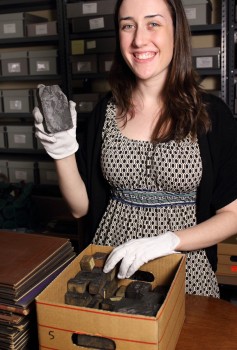Historical Summer

Details
This summer, Christy Tavernelli '13 is carving her way through a catalog of woodblock prints at the Library Company of Philadelphia (LCP). Her internship, which was held last year by Haverford alum Liz Crooks '12, is being funded by a John B. Hurford '60 Center for the Arts and Humanities stipend. Her primary responsibilities include scanning the woodblocks, which were purchased from the American Sunday School Union, a now- defunct Methodist organization, and entering comments about them into the database. “There are over 6,000 blocks,” she says,“so I'm only making a small dent in the collection this summer, but I'm still learning a lot along the way.”
LCP is an independent research library founded in 1731 by Benjamin Franklin. It specializes in American history and culture from the 17th to 19th centuries and served as the Library of Congress from the Revolutionary War until 1800. Afterwards, it remained the largest public library in America until the Civil War.
The woodblocks Tavernelli is working with were used to print a large amount of literature for Methodist missionaries in the 19th century. One of the most common publications was The Child's World, which was aimed at children across the nation.“[There are] a lot of stories where children are instructed to behave in ways that seem totally improbable,” says Tavernelli, who observes that the texts tell kids to act in“incredibly adult and self-abnegating ways,” such as cheerfully taking care of younger siblings instead of playing and having fun.
Other stories focus on religion, she says, and often tell of a solitary faithful child in a country of non-Christians. Some of the block prints demonize Catholics in various ways. Others, such as one picturing a snake rising out of a bottle, preach the dangers and familial repercussions of alcohol.
Tavernelli first got involved with the Library Company last semester when she took Professor Elliot Shore's History of Philadelphia course at Bryn Mawr College. The class took a number of field trips into the city, including one to LCP. Part of what drew her to the library, Tavernelli says, was her interest in finding out“how it struck the balance between maintaining its extensive collection and being friendly to the public.” What she's discovered is that the LCP website is a huge resource that is constantly updated by interns and staff with scans and photographs of the library's collection. There is also a small exhibition space whose exhibits are put together by a guest lecturer in collaboration with the LCP staff, says Tavernelli, who observes that this allows for scholarly discourse and exchange while making the material available to casual visitors.
In addition to her cataloging responsibilities, Tavernelli is also getting the chance to meet many scholars-in-residence.“It's really great to be able to talk to them or even just see the tentative titles of their projects,” she says
—Jack Hasler ‘15



